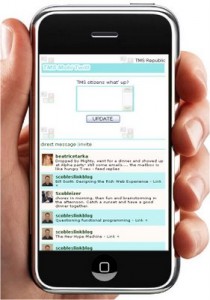Twitter is approaching a critical mass in users, and they’re a mobile bunch. These two factors, substantiated in a recent Pew Internet and American Life report, make 2009 the year when place-based events finally get a strong boost from Twitter.
 A recent report by the Pew Internet and American Life project shed some light on the typical U.S. Twitter user. This person is more “mobile” than the norm: “As a group they are much more likely to be using wireless technologies — laptops, handhelds and cell phones — for internet access, or cell phones for text messaging,” according to the report.
A recent report by the Pew Internet and American Life project shed some light on the typical U.S. Twitter user. This person is more “mobile” than the norm: “As a group they are much more likely to be using wireless technologies — laptops, handhelds and cell phones — for internet access, or cell phones for text messaging,” according to the report.
Here are a few other highlights:
- Twitter users are young. Their median age is 31. In comparison, the median age of a MySpace user is 27, a Facebook user is 26 and a LinkedIn user is 40.7
- Most likely because of this comparative youth, Twitter users are slightly more racially and ethnically diverse than is the full US population “Younger Americans are a more ethnically and racially diverse group than is the full population,” according to the report.
- Users of Twitter are reaching a critical mass: 11% of online American adults said they used a service like Twitter that allowed them to share updates about themselves or to see the updates of others.
What this means for marketers is that they can begin seeing real benefits from crowdsourcing their place-based events, even with less tech-savvy users. Expect to see more messages like this one in the months to come: “Come see us at [event name] today. Bring [related object or clipping] and receive a free [premium]. Please re-Tweet!”
